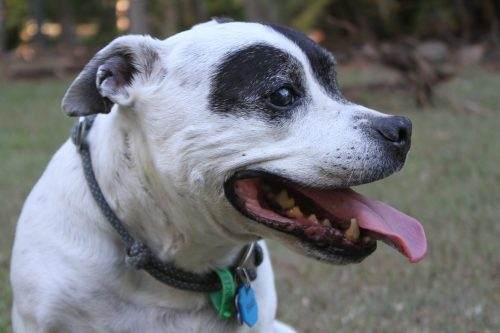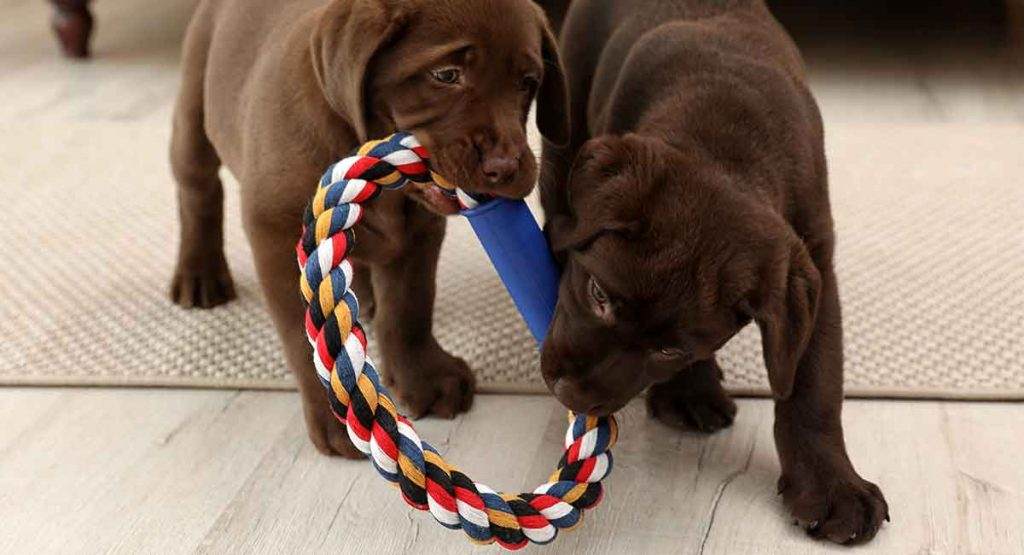We’ve all seen the cute memes online, where an owner places their dog in front of a mess or disaster the dog is clearly responsible for, and a card explaining what happened. These are fun ways to make fun of both our furry friends and more often, our own behavior as pet owners.
But is the dog actually guilty? Or just a victim of bad PR? Studies show that dogs, in general, aren’t actually capable of feeling guilt as we understand it. But dog lovers argue. The dog definitely gives off certain behavior cues when they’ve done something wrong. And a dog that’s bonded to their human will definitely show signs they understand when we’re upset with them.
So if a dog doesn’t feel guilty, what’s going on? Dog trainers and animal behaviorists say that the guilt that dogs feel isn’t exactly what we experience as guilt in humans.
But that doesn’t mean the dog doesn’t understand what’s happening. Read on to learn about so-called guilty behaviors in dogs, and better understand your dog’s behaviors. It will help with training, and strengthen your relationship with your furry friend!
Signs Of Guilt In Dogs
Those pet owners who swear their dog is capable of guilt describe a set of behaviors they ascribe to the dog’s guilt for misbehaving. These can include:
- Tucked tail
- Avoiding behavior, like running away, hiding, or avoiding your eyes
- Cowering posture
- Flattening Ears
- Licking
In reality, these are usually a sign of a dog’s stress or fear level. If a dog is a rescue, who has come from an aggressive home or unpredictable situation, you may see this set of behavior and often not understand the triggers.
Though avoiding and cowering, as well as the compulsive licking that can be seen as contrition may look a lot like human guilty behavior, it’s really just your dog being nervous, and not knowing what will happen next.
The truth is, animal behaviorists are still trying to prove either way. But since dogs don’t have the same relation to cause and effect, or even a sense of time like humans do, it seems highly unlikely that a dog is capable of feeling responsible enough for something to feel bad about it.
Guilty dogs look like these.
What Exactly Is Guilt?
On average, humans are shown to experience about 5 hours of guilt per week. Guilt can be a fairly destructive force, especially over the long-term. It can impact your sleep cycles, make you irritable, and even cause you to lash out at the person who makes you feel guilty.
Though it causes us a lot of problems, it’s generally considered to be a pro-social behavior. We feel guilty because we care about the people around us.
And from an evolutionary standpoint, there is even evidence that says we feel guilty in order to discourage behaviors that may cause us to be cut off from social groups.
Dogs also feel a strong need for companionship. When we’re upset with them, it can cause a lot of stress. But a dog doesn’t have the same awareness of cause and effect in relation to time that we do. It’s this connection that is thought to be essential to guilt.
After all, one of the most common features of guilt is that you feel bad a period of time.
And one of the most common reasons to feel guilty is that you’ve actually done something wrong. Dogs don’t have the same relationship to the things they’ve done, since they don’t have the same grasp of time, or a doggy concept of responsibility, for that matter.
This may seem inconsequential, but misunderstandings about how dogs see their own behavior has led to terrible training practices, some of which only encourage bad behavior in dogs, even when they don’t mean to.
Mistakes You Might Be Making In Training
Have you ever rubbed a dog’s nose in his mess when he goes on the rug? Science says that not only is this a bad move for pet parenting, it’s also almost entirely ineffective. The dog may understand that you’ll be unhappy at the mess in the rug.
And the stress may cause him to exhibit behaviors that look like guilt in humans. But he doesn’t really understand that he’s responsible for the mess.
Have you ever come home from work and found a garbage bag tipped over, or a pile of papers chewed up, only to have your dog look at you expectantly? He’s not waiting for you to react. He’s actually waiting for the humans to do what humans do, and fix the problem. This is why experts say it’s a better idea to train against bad behavior entirely, rather than punish bad behavior when it happens.
To a dog, any attention is still attention, and aggressive behavior from you, even if it’s just a raised voice or a swat on the nose, can cause the dog to stress, and may even encourage aggressive behavior, on top of the bad behavior!
Signs of Stress In Dogs
Many things can be a cause of stress for dogs, such as moving to a new home or having a new person in the house. A new pet, a new baby, or even a different smell in the area can have an impact on your dog. This may lead to signs of stress, or even cause a dog to regress, and misbehave.
Like the pet owners who attribute some stress behaviors to guilt, some may attribute this to jealousy, or homesickness. But it’s simply a dog’s response to a break in the routine and a redrawing of boundaries.
Double down on your training, and help the dog feel more at home with his new circumstances, and you’ll soon see improvement.
Dog Training Tips Which Can Keep Stress and Guilt Away
So how do you keep your dog stress-free without resorting to punishment behavior that can make things worse? There are a few principles to keep in mind.
1. Train Early, Retrain Often
Starting early, whether you have a pet, or an adult dog from a shelter is essential to set up your training routine. If you’ve had the dog for a while already, and haven’t established a training regimen, you’ll immediately notice issues with boundaries, and general behavior difficulty.
Some animal behaviorists suggest this is in response to an internal fight for dominance. But it’s more likely the result of a dog who doesn’t know what to expect. Keep your dog with you when you can, to help him establish boundaries.
Most dog trainers suggest a dog not be let off the leash for the first six months, even in the house, so the dog will understand where it should and should not be early on.
2. Establish A Routine
To go along with that last point, routines are important. Though dogs don’t have the same sense of time that we do, they are capable of understanding when dinner or walking is at a consistent time. Dogs do best when they know what to expect.
Set a routine for you and your dog as early as possible, and make it easier for the dog to focus on following your cues.
A simple overall dog routine looks like this.
3. Learn Your Dog’s Signals
When you and your dog have been together for a while, you’ll start to be able to read each other. Knowing what your dog’s stress signals look like allows you to act quickly, and remove your dog calmly from a stressful situation. Remember too, your dog can also read your signals.
Dogs who sense their humans are in distress, often exhibit their own stress symptoms. That’s why it’s important to remain calm during training or walking your dog, especially when approaching a trigger, like another dog, or a walk in a new neighborhood.
4. Set Boundaries and Enforce Them Regularly
Even the best-behaved dogs aren’t saints. Make it easy for your dog to be good. Keep garbage covered and sealed and in the same spot every day. Keep electrical cords tied and out of the way. Seal up your food.
Keep a dog out of a room where he could destroy something important using baby gates and training tools. With time, your dog can be made to understand which places in the house are his, but you should be prepared to make that as easy and stress-free as you can, by making it an effort for your dog to break the rules.
5. Keep Your Dog Happy With Time For Play And Training
Finally, dogs tend to stress out and misbehave if they aren’t getting enough exercise, mental or physical. This can lead to pacing, chewing, and barking. Curb these problems by getting plenty of exercise. The specific needs vary depending on breeds, but dogs need to be kept busy both physically and mentally.
Trick training or sports like Frisbee can help your dog burn off energy, and prevent stress. It also helps strengthen the bond between the two of you, meaning that it will be easier to pick up on each other’s cues.
For a dog’s mental energy, you can try a treat puzzle, like a Kong ball, which automatically rewards a dog for learning how to get the treat out!
Training Older Dogs Against Stress
That’s all well and good for puppies. But what about older dogs? The truth is, aside from breaking down bad habits, your training of older dogs should not change significantly than the way you would train a puppy.
It may just take a little more time to get the message that the ingrained bad behaviors need to change. Though dogs don’t feel guilty in the traditional sense, a dog will thrive under routine and your expectations. Dogs are loyal, and a good dog will be eager to please, and in tune with your own distress.
An older dog may take a longer time to learn the basics of house training, but the more time you have to become attuned to the dog’s needs and stress signals, the easier and faster your training will go.

Conclusion
Dogs are intelligent, devoted, and adorably expressive. But as unique as your relationship with your pet may be, guilt is a complex concept that requires an understanding of the cause, effect, and time.
Though research suggests that human guilt is a trait borne of years of evolution, it’s hardly an animal instinct. Dogs simply don’t have the complex system needed to process feelings of guilt.
What pet owners read as guilt is usually a fear or stress response. Dogs don’t have the same concept of cause and effect, so they’re not capable of being motivated by feeling bad about something that happened.
Instead, to properly understand and keep your dog healthy and safe, your training should center on preventing bad habits from starting, rather than punishing them once they have.
References
- https://www.tandfonline.com/doi/pdf/10.1080/21674086.1956.11926038
- https://etologia.elte.hu/file/publikaciok/2012/HechtMG2012.pdf
Table of Contents




